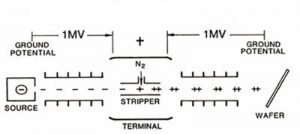Both S-series and U-series Pelletrons can either be single-ended or tandem. In both cases, ion beams (both positive and negative) are accelerated by an electrostatic field, i.e. a potential drop, resulting in a true DC beam.
 In single-ended Pelletron systems, one end of the Pelletron has a high-voltage terminal containing a positive ion source such as our Positive RF source or an electron source. The other end of the Pelletron is at ground, where the ion/electron beam emerges with an energy roughly equivalent to the terminal voltage. Typically there is only one source in the terminal, however it is possible to include both a positive source and an electron source in the terminal. This would allow the production of positive ions or electron beams from a single system.
In single-ended Pelletron systems, one end of the Pelletron has a high-voltage terminal containing a positive ion source such as our Positive RF source or an electron source. The other end of the Pelletron is at ground, where the ion/electron beam emerges with an energy roughly equivalent to the terminal voltage. Typically there is only one source in the terminal, however it is possible to include both a positive source and an electron source in the terminal. This would allow the production of positive ions or electron beams from a single system.
 By contrast, in tandem accelerators, both ends of the Pelletron are at ground, with the high-voltage terminal in the middle. Tandems are always charged positively, allowing the negatively charged injected ions produced by any of our negative ion sources to accelerate to the terminal. Inside the terminal is a stripper, which uses a gas (usually N2 or Ar) or a thin carbon foil to collisionally remove electrons from the incoming negative ions. The now positively-charged ions experience a second boost of acceleration (hence the name “tandem”) as they exit the terminal and travel through the acceleration tube to ground at the high-energy end of the Pelletron.
By contrast, in tandem accelerators, both ends of the Pelletron are at ground, with the high-voltage terminal in the middle. Tandems are always charged positively, allowing the negatively charged injected ions produced by any of our negative ion sources to accelerate to the terminal. Inside the terminal is a stripper, which uses a gas (usually N2 or Ar) or a thin carbon foil to collisionally remove electrons from the incoming negative ions. The now positively-charged ions experience a second boost of acceleration (hence the name “tandem”) as they exit the terminal and travel through the acceleration tube to ground at the high-energy end of the Pelletron.
Primary benefits of each configuration
Single Ended:
- Ability to utilize positive ion source directly without charge exchange, resulting in much higher beam currents than a traditional tandem
- Lower energy spread allows higher beam brightness
- Compact accelerator footprints are available
Dual Ended (Tandem):
- Higher beam energies are possible for a given terminal voltage due to the additional acceleration
- External ion sources are easier to maintain
- Multiple ion source configurations are available, leading to more universal systems